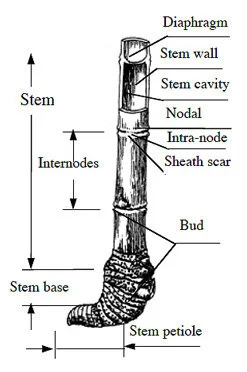Bamboo Stem Anatomy
The bamboo stem (culm) is the most utilized part of the bamboo plant, and consists of 3 parts:
1. Stem
The stem is the part of the bamboo plant that grows above the ground, it is usually straight and cylinder-formed (to some extent oval). These bamboo stems have nodes (diaphragms) between two internodes, that strengthen the stem.
The length, number and form of nodes and internodes depend on the bamboo species. Internodal length is also much shorter towards the base of the culm compared to the internodal length towards the tip of the culm.
Every node has two closely positioned rings, the lower one is called sheath ring, which is a scar formed after the sheath leaf falls off. The upper one is called stem ring, which is a scar formed after the growth-cease of internode tissue. The part between the rings is the node itself.
Bamboo internodes are usually hollow inside and form bamboo cavities. Depending on the bamboo species, wall thickness of the stem can vary greatly from thin walled to even solid. A good example of a near solid bamboo species is Guadua amplexifolia.
2. Stem Base
The lower part of a bamboo stem is called stem base, it extends into the soil and connects to the rhizome and root system. A stem base consists of numerous short sections with significant diameter, adventitious roots grow densely on these sections. On the stem bases of some bamboo species there are up to ten alternate buds, which grow into shoots and then into bamboo stems; on those of some other species the buds are fewer, and can grow into rhizomes.
3. Stem Petiole
The stem petiole is the lowest part of the bamboo stem, and consists of tens of short sections. The diameter of these sections decrease with the depth of the petiole. A stem petiole is generally solid, with degenerated leaves, without buds.

